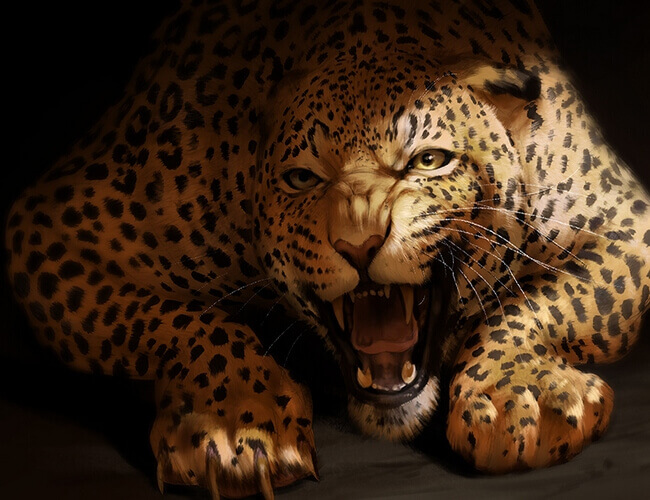
Jaguar
The national animal of Brazil is jaguar. Its scientific name is Panthera Onca. It belongs to the family of Felidae and class of Mammalia. This solid and well-muscled animal is the largest cat in the New World and the largest carnivorous mammal in Central and South America. It’s weights are normally in the range of 55–96 kg (123–211 lb).
The largest of the male kind have been recorded to weigh as much as 158 kg (348 lb). The smallest of females kind have low weights of 36 kg (79 lb).
The percentage ratio of male and female is 30 to 10 mostly. Length wise it has different configuration it may be 1.12 to 1.85 m (3.7 to 6.1 ft.) from nose to base similar to cats.
The Jaguar tails length is 45 to 75 cm (18 to 30 in) when compare with big cat. Also having short legs compared to tiger or lion in a same weight range. But are heavy and powerful.
Approximately 63 to 76 cm (25 to 30 in) tall at the shoulders. When to compare with Old World leopard, the jaguar is bigger, heavier and relatively solid in build.
Read Also: National animal of New Zealand
The base wool of the jaguar is normally a yellowish-brown. It can be range to reddish-brown and black color for most of the body. However, the lower area of the animal is white. There are spots on the different parts of the jaguar it may be several dots or large spot. The spots on the head, neckand tail are normally solid, which may combine to form a band.
Brazil national animal has close similarity with leopard. This two animals can be differentiated by their rosettes(an ornament or pattern resembling a rose that is worn as a badge of office or as recognition of having won an honor) this decorated badges on a jaguar’s skin are larger, fewer in number, usually darker, and have thicker lines and small spots in the middle that the leopard lacks. Jaguars also have rounder heads and shorter, stockier limbs compared to leopards
Meaning.
The word ‘jaguar‘ comes to English from one of the Tupi–Guarani languages, Tupian languages of South America. It includes fifty languages, including the best-known languages of the family, Guarani.in Tupian language the word yaguara “beast”, is sometimes translated as “dog” The precise word for jaguar is yaguareté, with the suffix -eté meaning real or true.
One part of Its scientific name is Panthera in Latin, in Greek this word use for leopard, which shows close similarity between jaguar and leopard.
Beside this, the name Jaguar comes from the Native American word Jaguar which means “he who kills with one leap“.
10 facts about jaguar
- Jaguar is the most popular and native animal of Brazil country.
- This aggressive animal lives alone and defines regions of many square miles by marking with their waste or scraping trees.
- Diet of Jaguar may consist of meat like deer, monkeys, peccary crocodiles, snakes, sloths.
- The Young species living with their mothers for two years or more after learning hunt.
- They are still hunted for their attractive coat. The landlord also kills them because the cats sometimes quarry upon their livestock.
- Females have litters of one to four trainees, to overcome the problem of blindness and helpless at birth. The mother stay with them to protect them from hunters even their fathers father.
- Young domestic cats stay with their mother from 1-1.5 years.
- The Brazil animal jaguar is lonely and global although it is an expert tree climber.
- It marks its zonal area with urine and tree jams, in the same way as the other great cats. It uses different languages or dialogs including, roars, grunts, and meows.
- The International Species Information Service lists 292 worldwide, with 95 being in the U.S.
- It is able to give birth to young (animals) or reproduce (organisms) with bothLeopards and Lions.
- According to a reported estimate, 15,000 Jaguar animals individuals left roaming the rain-forest today.
History of Jaguar
As we know that, Jaguars are the most largest Big cats of South America. It is also confirmed from sources that jaguar becomes the third biggest felid in the world after lion and tiger. The final taxonomic delineation of Jaguar subspecies was performed by Pocock in 1939. They are mostly found in remote regions of Central and South America.
Population: The estimated numbers of jaguars are 15,000 remain in the wild. A small population of 80 ti 120 cats are in the remote mountains of Sonora and Mexico bordering Arizona.
Why is jaguar the national animal of Brazil
Brazil has several animals but officially jaguar is accepted. It has a large size and dominant nature, there are no other wild animals that are known to actually consider it as a target.
The young jaguar is a highest value killer or target searcher, meaning it exists at the top of its food chain and is not preyed on in the wild.
It has also a large effect on its environment relative to its abundance keystone species, as it is assumed, through controlling the population levels of prey such as herbivorous and granivorous mammals, apex felids maintain the structural integrity of forest systems. Due to all these facts jaguar officially becomes the national animal of Brazil. This was a detail guide about Jaguar. Kindly do let us know your thoughts about Jaguar animal.
Check Also: National animal of Australia

